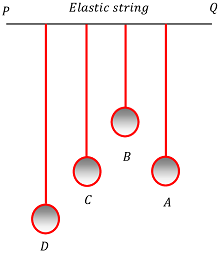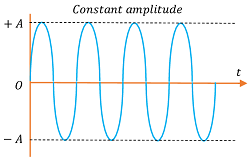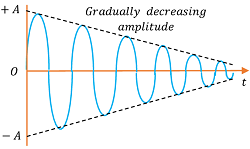What is called Resonance?
Resonance is a particular case of forced oscillations in which the frequency of the driving force becomes equal to the natural frequency of the oscillating body which results in producing of extremely large amplitude of oscillations.
Resonance is a phenomenon associated with forced vibrations. When a body is set into vibrations, initially it tries to vibrate with its own natural frequency ( \nu _ 0 ) . This is called free vibrations.
Suppose, an external periodic force of frequency ( \nu ) is applied to the vibrating body. This is called driving force. The applied force tries to drive the body with its own frequency of vibration ( \nu ) .
Hence, the free vibrations of the body will die out and finally the body will be vibrating with constant amplitude and with the frequency ( \nu ) of the driving force. This is called forced vibrations.
At start, the frequency of the driving force is zero and thereafter it goes on increasing to a large value. In dynamic equilibrium conditions following observations are made.
- When ( \nu < \nu _ 0 ) or ( \nu > \nu _ 0 ) , the amplitude of the forced oscillations are very small due to superimposing effect.
- But a situation will arise when ( \nu \simeq \nu _ 0 ) . At this time, the amplitude of the forced vibrations become very large. This phenomenon is called resonance.
Therefore, required condition for a resonance to occur is –
\text {Frequency of driving force} \ ( \nu ) = \text {Natural frequency of vibrating body} \ ( \nu_0 )
Examples of Resonance
Some natural examples of resonance are –
- In a resonance tube, the air column produces a loud sound when its frequency matches with the frequency of tuning fork.
- A glass tumbler or a piece of china-ware on shelf is set into resonant vibrations when some note is sung or played.
- Playing with JAL TARANG.
- Wen the frequency of driving force in a machine equals to the natural frequency of machine bed, vibration of machine with large amplitudes and heavy noise are noticed.
Experimental illustration of Resonance
An experiment with four pendulums is conveniently used to demonstrate the phenomenon of occurrence of resonance. Consider about the setup as shown in figure.
Four pendulums named A , B , C and D are suspended from an elastic string PQ as shown in figure. Let, the pendulum A is set into oscillations. It will start oscillating with its own natural frequency.
The energy from pendulum A get transferred to other pendulums through the elastic string PQ . Initially the motions of pendulums B , C and D are irregular as they trying to oscillate with their own natural frequencies which depends upon their thread lengths. But soon all these pendulums start oscillating with the frequency of A .

The oscillations of B , C and D are forced oscillations.We know that, frequency of a pendulum is given by –
\nu = \left ( \frac {1}{2 \pi} \right ) \left ( \sqrt {\frac {g}{l}} \right )
Or, \quad \nu \propto \left ( \sqrt {\frac {1}{l}} \right )
Therefore, following observations are made in dynamic equilibrium conditions –
- Thread length of pendulum B is shorter than that of A . Hence, frequency of pendulum B will be larger than that of A and oscillates with small amplitude of oscillations.
- Length of pendulum D is larger than that of A . Hence, frequency of pendulum D will be smaller than that of A and oscillates with large amplitude of oscillations.
- Thread length of pendulum C is equal to that of A . Hence, pendulum C oscillates with same frequency as that of A with largest amplitude.
- Hence, the oscillations of C are resonant oscillations.
Types of Oscillations
Oscillations are classified into following categories depending on the nature of medium and forces acting on the body.
- Free oscillations.
- Damped oscillations.
- Forced oscillations.
- Maintained oscillations.
Characteristics of these types of oscillations are discussed below.
1.Free Oscillation

If a body is set into oscillations, it starts oscillating with its own frequency which is called natural frequency and such oscillations are called free oscillations or free vibrations.
A free vibration or oscillation occurs in a medium which offers no resistance to vibrations. If a medium offers a resistance to the vibrations, then it is called a dissipating medium.
A free oscillation is also called an undamped oscillation or undamped vibration.
Consider about the amplitudes of free oscillations of a body in absence of a dissipating medium as shown in figure.
Let, ( k ) is force constant and ( m ) is the mass of the oscillating body. Then, natural frequency of free oscillations is given by –
\nu _ 0 = \left ( \frac { 1 }{ 2 \pi } \right ) \sqrt { \frac { k }{ m }}
The characteristics of free oscillations are –
- The body oscillates with its own fixed natural frequency.
- In the absence of dissipating medium, amplitude of oscillations remains constant with pass of time.
- Natural frequency of oscillations depends upon mass ( m ) and force constant ( k ) .
EXAMPLE –
Some examples of free oscillations are –
- Free vibrations of prongs of a tuning fork in vacuum.
- Free vibrations of string of sitar in the absence of friction medium.
2.Damped Oscillation
Damped oscillations are those in which the amplitude of oscillations decreases exponentially with the passage of time due to the presence of friction offered by the dissipating medium.

The characteristics of damped oscillations are –
- The body oscillates with its own natural frequency.
- Amplitude of oscillations gradually decreases with time due to friction of dissipating medium.
- Due to friction, amplitude decreases and oscillation eventually dies out.
- Friction of the dissipating medium has following effects on oscillations –
- Friction loss changes the simple harmonic motion of oscillating body into a periodic motion.
- It gradually decreases the amplitude of oscillations.
- It slightly reduces the frequency of oscillations.
EXAMPLE –
In actual practice most of the oscillations occur in viscous medium such as air, water etc. These are dissipating medium. Thus, oscillations in these medium are damped oscillations.
3.Forced Oscillation
When a body is set to oscillate under the influence of an external periodic force, it is called a forced oscillation.
A forced oscillation has the following characteristics –
- The oscillating body not oscillates with its own natural frequency but it is forced to oscillate with the frequency of the external periodic force called driving force.
- Amplitude of the oscillation is maintained at constant level by the driving force.
EXAMPLE –
Some examples of forced oscillations are –
- Vibration of moving vehicles.
- Shaking of washing machines due to imbalance.
4.Maintained Oscillation
The oscillations in viscous medium of air and water are damped oscillations. The energy of the oscillating system gradually diminishes in overcoming friction and resisting forces of medium. Eventually the oscillations die out with passage of time.
Therefore, if an external source is applied to the oscillating body which provides energy at the same rate at which the energy is being lost in friction by the dissipating medium, then the amplitude of oscillations can be maintained at constant level. Such oscillations are called maintained oscillations.
The characteristics of maintained oscillations are –
- The body oscillates with its own natural frequency.
- Amplitude of oscillations is maintained constant at constant level by the application of an external source of energy.
EXAMPLE –
Some examples of maintained oscillations are –
- The oscillation of “balance wheel” of a watch in which main spring provides the required external source of energy.
- A child’s swing in which external energy is continuously fed by a person to maintain the amplitude of oscillations.
See numerical problems based on this article.
